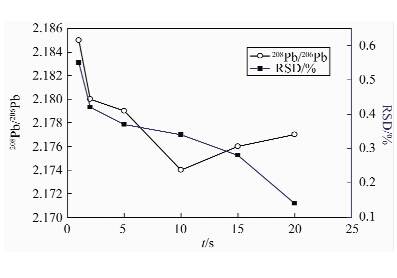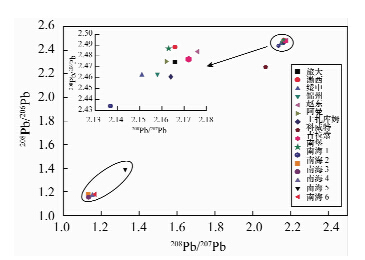Determination of Pb Isotopes in Crude Oil by ICP-MS and Application in Identification of Oil Sources
-
摘要: 海洋溢油事件时有发生,探索基于铅同位素特征信息为指标的溢油鉴别技术,在海上溢油鉴别中有着十分重要的意义。本文利用极性较强的二氯甲烷溶解原油样品,分散均匀后在浓硝酸-双氧水氧化消解体系下微波消解,采用电感耦合等离子体质谱法(ICP-MS)测定原油中铅的含量及铅同位素比值(208Pb/206Pb、208Pb/204Pb及208Pb/207Pb),建立了基于铅同位素为特征信息的一种新的油源鉴别辅助技术。实验优化了ICP-MS工作参数,并利用铅标准溶液对同位素积分时间进行优化,提高同位素测定的精密度。结果表明,原油中铅元素测定方法的准确度较高,不确定度<5%,重现性较好,相对标准偏差小于2%(n=3)。该方法应用于测定渤海、南海及国外不同来源的原油样品,分析结果显示不同地区原油中铅元素含量的差异性较大,浓度范围为37.99~1213.00 μg/kg。考察了铅同位素比值信息,以208Pb/207Pb与208Pb/206Pb 为变量,能够对不同区域原油样品进行分类,我国南海原油样品与其他油源的原油样品差异性明显。本文建立的油源鉴别技术能为油源的初步筛选提供一定的辅助作用。
-
关键词:
- 原油 /
- 铅同位素 /
- 电感耦合等离子体质谱法 /
- 油源鉴别
Abstract: Oceanic oil spill incidents occur from time to time making it extremely important to establish a new identification method based on Pb isotope information. This method involves dissolving the crude oil in organic solvent (CH2Cl2), which is a strong polar solvent, and then digesting by microwave with HNO3-H2O2 as the oxidant. The concentration and isotopic compositions of Pb (208Pb/206Pb, 208Pb/204Pb and 208Pb/207Pb) were measured under the optimum conditions of Inductively Coupled Plasma-Mass Spectrometry (ICP-MS). The accuracy and precision were also studied. The results show that the method is accurate, with a relative error of less than 5%, and a precision with RSD less than 2% (n=3). The dwell time for different Pb isotopes was also optimized by using Pb standard solution in order to improve the accuracy and get the best integration time. The concentrations of Pb in crude oil from Bohai, Nanhai and other countries was measured, and the concentration range of Pb in all crude oil was 37.99-1213.00 μg/kg demonstrating obvious differences. Meanwhile, the ratios of different Pb isotopic compositions were measured and further processed by cluster analysis by taking 208Pb/207Pb and 208Pb/206Pb as independent variables. It could be seen that the crude oil from different areas can be classified, especially the Nanhai oil. The study could provide some assistance for other identification of oil sources by preliminary screening. -

-
表 1 ICP-MS仪器工作参数
Table 1. The working parameter of ICP-MS
工作参数 设定条件 射频功率 1350 W 采样深度 6.8 mm 等离子体气体流量 16.0 L/min 辅助气流量 1.00 L/min 载气流量 1.12 L/min 采样锥(Ni)孔径 1.0 mm 截取锥(Ni)孔径 mm 采样速度 1.0 mL/min 分析模式 全定量 数据采集重复次数 3 驻留时间 30 ms 单位质量数采集点数 3 积分时间 1 ms 表 2 微波消解工作程序
Table 2. The digesting program of microwave digestion
步骤 最大功率P/W 功率百分比/% 升温时间t/min 摄氏温度θ/℃ 保持时间t/min 1 1600 100 3 100 3 2 1600 100 7 150 3 3 1600 100 5 170 3 4 1600 100 5 190 10 表 3 油样标准样品测定结果
Table 3. Analytical results of Pb in oil standard sample
样品编号 w(Pb)/(μg·g-1) 相对误差/% 参考值 测定值 油样(WM-21-1X-4) 10.00±1.08 10.95 4.58 油样(WM-21-5X-4) 50.00±0.94 50.21 3.13 表 4 不同来源油样品Pb测定结果
Table 4. Analytical results of Pb in crude oil from different area
原油产地 w(Pb)/(μg·kg-1) 阿曼 686.40 阿联酋 81.40 锦州 387.50 刚果 1213.00 科威特 30.70 辛巴威 836.10 安哥拉 93.80 赤道几内亚 365.40 沙特(轻质油) 857.80 沙特(中质油) 69.70 沙特(重质油) 82.10 印尼) 79.30 厄瓜多尔 79.80 旅大 695.40 绥中 469.60 赵东 732.50 渤海渤中 293.30 渤海渤西 769.20 渤海埕岛 75.73 南海001 253.10 南海002 115.90 南海003 132.50 南海004 136.70 南海005 37.99 南海006 132.70 南海007 103.20 表 5 油样中Pb同位素比值稳定性测定结果
Table 5. Stability test of Pb isotope determination in crude oil
同位素比值 Pb同位素测定结果 RSD/% 本法分次测定值 平均值 208Pb/206Pb 2.166 2.191 2.181 2.163 2.172 2.151 2.171 0.65 208Pb/207Pb 2.474 2.512 2.463 2.490 2.482 2.469 2.482 0.71 208Pb/204Pb 1.127 1.130 1.128 1.129 1.124 1.131 1.128 0.22 207Pb/204Pb 0.455 0.467 0.443 0.462 0.454 0.456 0.456 1.78 206Pb/204Pb 0.523 0.513 0.520 0.509 0.531 0.527 0.521 1.60 表 6 源油样品中Pb同位素测定结果
Table 6. Analytical results of Pb isotope in crude oil
油源 208Pb/206Pb 208Pb/207Pb 208Pb/204Pb 207Pb/204Pb 206Pb/204Pb 旅大 2.166 2.474 1.127 0.455 0.520 渤海渤西 2.166 2.488 2.426 0.975 1.120 绥中 2.151 2.463 1.927 0.783 0.896 渤海渤中 2.158 2.476 2.540 1.026 1.177 锦州 2.176 2.484 0.664 0.267 0.305 赵东 2.162 2.475 0.568 0.230 0.263 绥中 2.163 2.476 1.501 0.606 0.694 阿曼 2.164 2.461 0.342 0.139 0.158 上扎库姆 2.068 2.256 0.037 0.016 0.018 杰诺 2.169 2.484 1.025 0.413 0.473 科威特 2.172 2.477 1.860 0.751 0.856 吉拉索 2.163 2.487 1.884 0.758 0.871 沙重原油 2.159 2.475 0.707 0.286 0.327 沙中原油 2.157 2.468 1.600 0.648 0.742 渤海南堡 2.137 2.434 1.148 0.472 0.537 南海1 1.132 1.177 0.473 0.401 0.417 南海2 1.134 1.151 0.241 0.209 0.212 南海3 1.153 1.175 0.092 0.078 0.080 南海4 1.706 1.783 0.021 0.012 0.012 南海5 1.326 1.388 0.017 0.012 0.013 南海6 1.166 1.178 0.549 0.466 0.470 -
[1] 曲良.我国海洋溢油污染防治发展浅析[J].海洋开发与管理,2012(5): 77-81. http://www.cnki.com.cn/Article/CJFDTOTAL-HKGL201205020.htm
[2] 李洪,吕吉斌,周传光,姚子伟,尚龙生,徐学仁,徐恒振,马永安.用荧光光谱和毛细管GC-FID法鉴别海面溢油[J].海洋通报,1998,17(6): 66-70. http://www.cnki.com.cn/Article/CJFDTOTAL-HUTB199806010.htm
[3] 徐振洪,朱建华,李溪.原油中金属资源综合利用的研究进展[J].矿产综合利用,1998(8): 22-26. http://www.cnki.com.cn/Article/CJFDTOTAL-KCZL199803007.htm
[4] 曹剑,吴明,王绪龙,胡文瑄,向宝力,孙平安,施春华,鲍海娟.油源对比微量元素地球化学研究进展[J].地球科学进展,2012,27(9): 925-936. http://www.cnki.com.cn/Article/CJFDTOTAL-DXJZ201209002.htm
[5] 刘小薇,程克明.微量元素在煤成烃研究中的应用[J].石油勘探与开发,1995,22(5): 40-44. http://www.cnki.com.cn/Article/CJFDTOTAL-SKYK505.010.htm
[6] 宗国宪,黄正吉.莺歌海盆地原油中微量元素分布特征及其地质意义[J].海洋石油,2003,23(4): 27-29. http://www.cnki.com.cn/Article/CJFDTOTAL-HYSY200304008.htm
[7] 管殿洪.微波等离子体原子发射光谱法(ICP/AES)测定原油中的微量金属元素[J].石油与天然气化工,2007,36(5): 420-422. http://www.cnki.com.cn/Article/CJFDTOTAL-LHJH201106030.htm
[8] Nakamoto Y, Ishimaru T, Endo N, Matsusaki K. Determination of vanadium in heavy oils by atomic absorption spectrometry using a graphite furnace coated with tungsten [J].Analytical Sciences APRIL,2004,20(4): 739-741. doi: 10.2116/analsci.20.739
[9] Maturing L K, Frost C D, Branthaver J F. Aneodydium isotopic study of crude oils and source rocks.potential application for petroleum exploration [J].Chemical Geology,1991,91: 125-138. doi: 10.1016/0009-2541(91)90086-7
[10] Bros R, Stille P, Gauthier-Lafaye F, Weber F, Clauer N. Sm-Nd isotopic dating of Proterozoic clay material,an example from the Francevillican sedimentary series, Gabon [J]. Earth and Planetary Science Letters,1992,113: 207-218. doi: 10.1016/0012-821X(92)90220-P
[11] Stille P,Gauthier-Lafage F, Bros R.The neodymium isotopic system as a tool for petroleum exploration[J].Geochunica et Cosmochimia Acta,1993,57:4521-4525. doi: 10.1016/0016-7037(93)90502-N
[12] 彭先芝,刘向,叶兆贤,吴建勋,张干.化学与稳定同位素指纹示踪原油类污染: 以广东南海两次小型溢油事件为例[J].地球化学,2004,33(3): 317-323. http://www.cnki.com.cn/Article/CJFDTOTAL-DQHX200403011.htm
[13] Wang Z D, Fingas M F.Development of oil hydrocarbon fingerprinting and identification techniques [J]. Marine Pollution Bulletin,2003,47: 423-452. doi: 10.1016/S0025-326X(03)00215-7
[14] 陈伟琪,张骆平.鉴别海面溢油的正构烷烃气相色谱指纹法[J].厦门大学学报: 自然科学版,2002,41(3): 346-348. http://www.cnki.com.cn/Article/CJFDTOTAL-HYHJ198602011.htm
[15] 宫景霞.正构烷烃气相色谱指纹法鉴别海面溢油源[J].福建环境,2002,19(6): 53-54. http://www.cnki.com.cn/Article/CJFDTOTAL-HYHJ198602011.htm
[16] 张景廉,朱炳泉.塔里木盆地干酪根、沥青的Pb同位素特征及其原油幔源非生物成因[J].甘肃地质学报,1997,6(A00): 84. http://www.cnki.com.cn/Article/CJFDTOTAL-GSDZ7S1.019.htm
[17] Shoce E L, Koretsky C M.Metal-organic complexes in geochemical processes: Estimation of standard partial molal thermodynamic properties of aqueous complexes between metal cations and monovalent organic acid ligands at high pressure and temperatures [J].Geochinfiea et Cosmochimica Acta,1995,59(8): 1497-1532. doi: 10.1016/0016-7037(95)00058-8
[18] 孙培艳,包木太,王鑫平,赵蓓,高振会,王修林.国内外溢油鉴别及油指纹库建设现状及应用[J].西安石油大学学报:自然科学版,2006,21(5): 72-78. http://www.cnki.com.cn/Article/CJFDTOTAL-XASY200605017.htm
[19] Zeigler C, Namara K M, Wang Z D, Robbat J A.Totalalky lated polycyclic arom atic hydrocarbon characterization and quantitative comparison of selected ion monitoring versus full scan gas chromatography/mass spectrometry based on spectral deconvolution [J]. Journal of Chromatography A, 2008, 1205: 109-116. doi: 10.1016/j.chroma.2008.07.086
[20] Wang Z D, Stout S A, Fingas M. Forensic fingerprinting of biomarkers for oil spill characterization and source identification environmental forensics [J].Environmental Forensics, 2006,7(2): 105-146. doi: 10.1080/15275920600667104
-




 下载:
下载:

